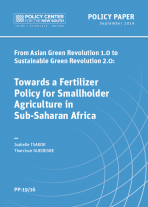From Asian Green Revolution 1.0 to Sustainable Green Revolution 2.0
This paper is about the basic principles which should guide fertilizer policy for smallholder agriculture in sub-Saharan Africa It is not about detailed country-specific prescriptions on the “how” of policy. This important task should constitute the substance of detailed country studies. The overarching goal here is to use fertilizer to spearhead and sustain an African Green Revolution (GR). In this paper, fertilizer use is not considered as an end in itself, but as a necessary means to transforming agriculture through sustained and broad-based productivity increases. This dual time frame—short and longer term—and the overarching developmental goal through which fertilizer policy should be viewed has major implications for shaping policy. For short term results, policy makers must at a minimum give farmers access to: (i) on the input side: the technical package of the GR, namely fertilizer, HYV seeds, pesticides, and water control; and (ii) on the output side: good access to potentially profitable markets. For longer term, transformational results (several decades at least), policy makers must create and sustain an overall policy and institutional environment in which smallholders’ interests occupy center stage in a way that is compatible and complementary with governments’ financial capability; and society’s legitimate concern for sustainable resource management; and increased resilience to climate change. What does this mean? For smallholders, it means that they should have secure tenure either as owners or tenants with usufruct rights to the land they till, in addition to the minimum conditions for short term results. For governments, it means that they should carefully consider how to balance their support for private or public goods and services, and the financial pot they can draw upon. For society, it means that the interest for sustainable resource management and for having a resilient agriculture must be furthered.










